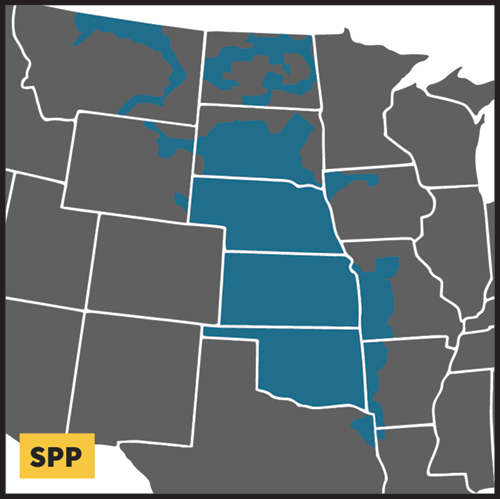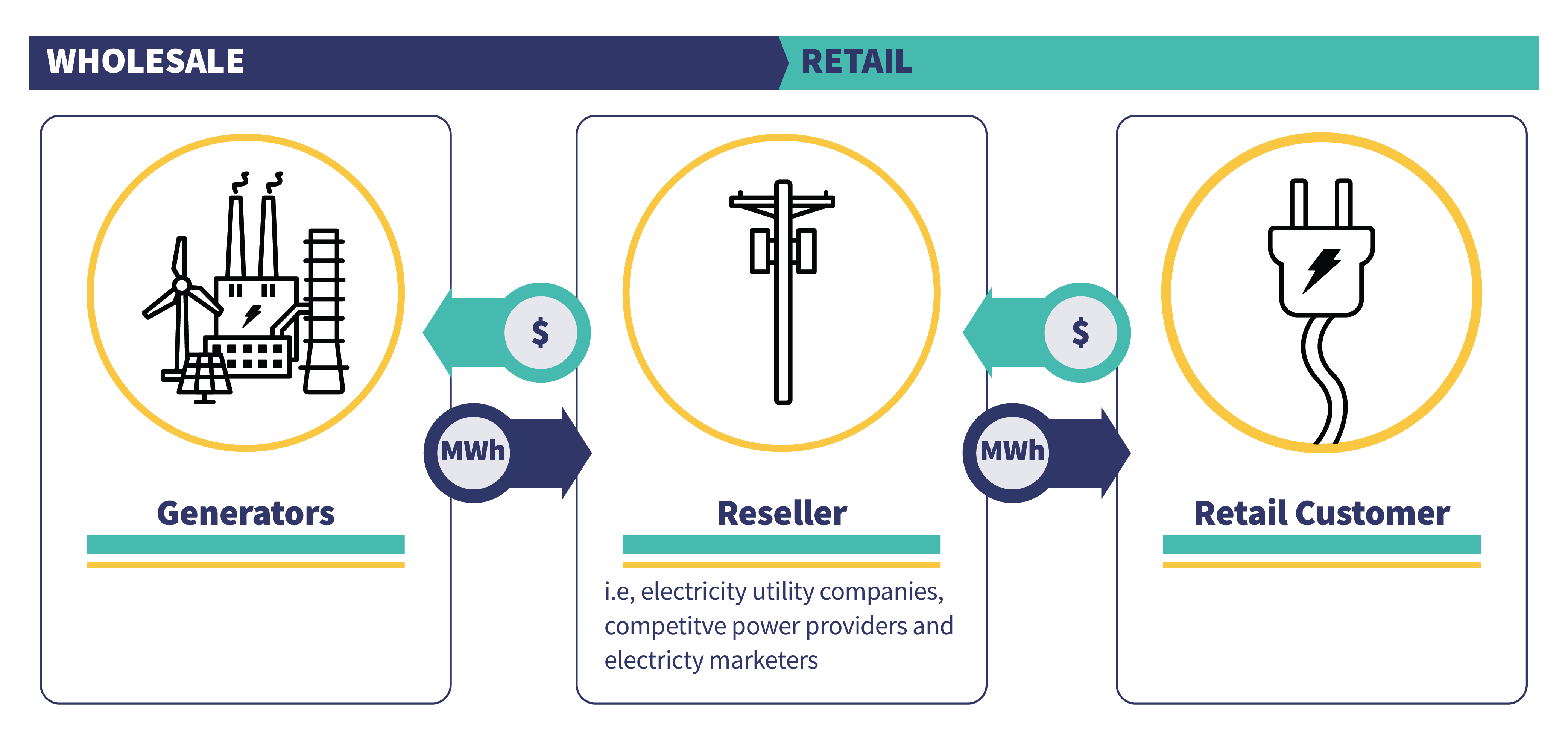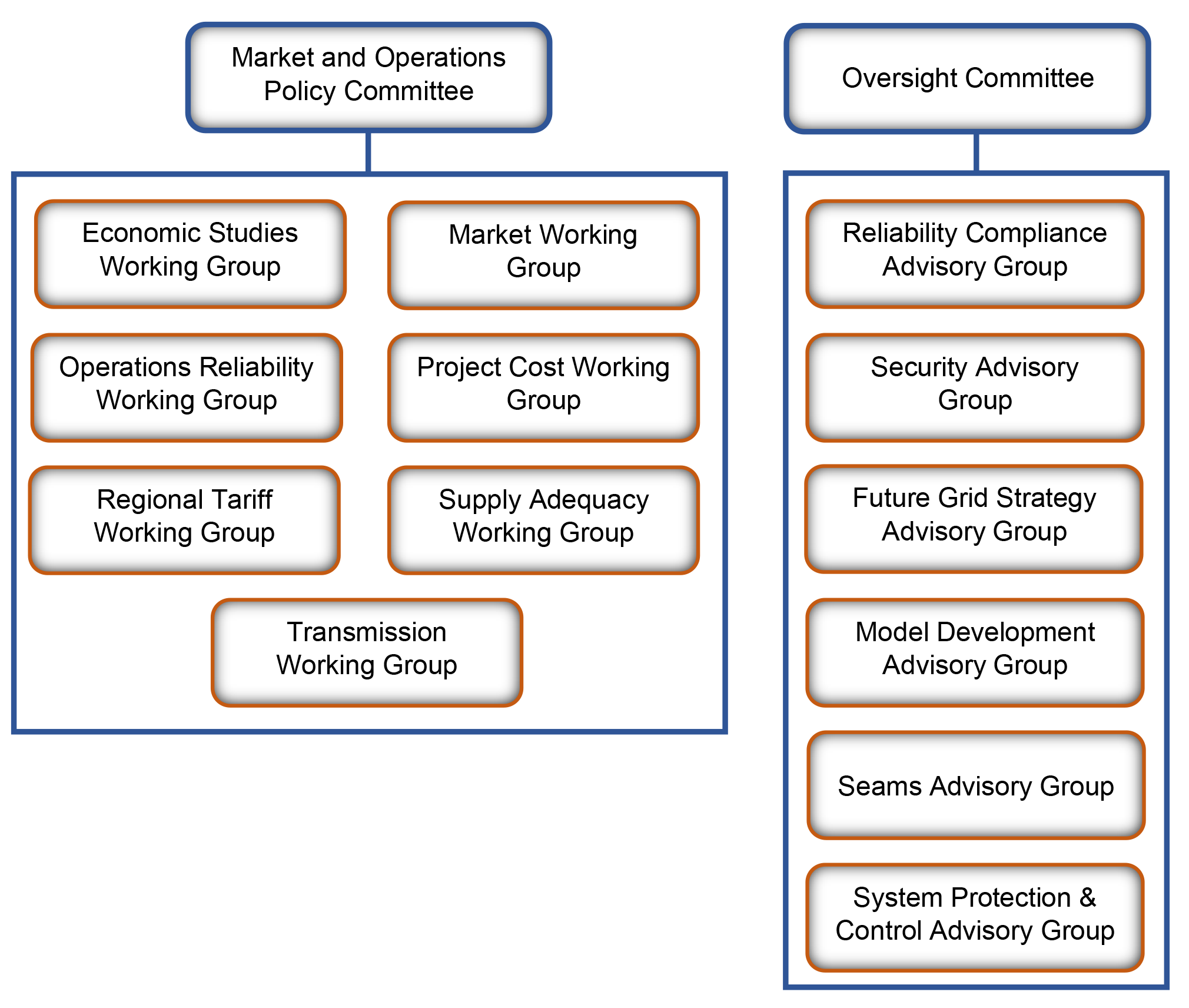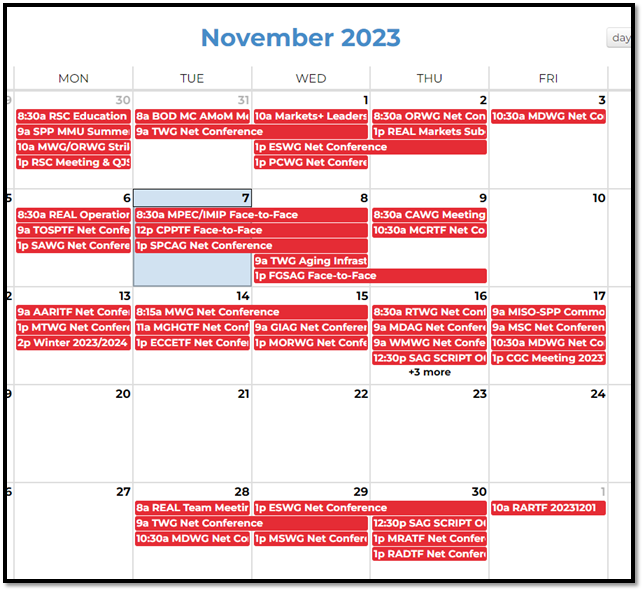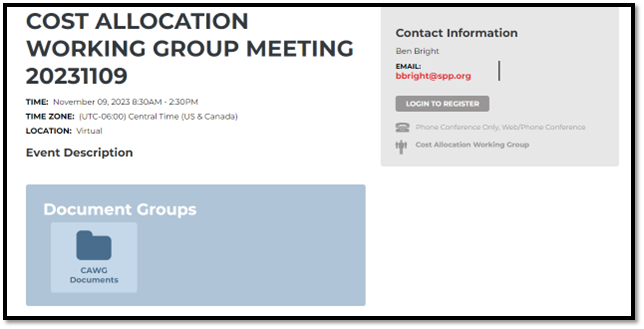Q. What is the Southwest Power Pool and what does it do?
A. Southwest Power Pool, Inc. (SPP) operates the electric transmission system or “grid” for all or parts of fourteen states in the Midwest and West, including Arkansas, Iowa, Kansas, Louisiana, Minnesota, Missouri, Montana, Nebraska, New Mexico, North Dakota, Oklahoma, South Dakota, Texas, and Wyoming. SPP is the independent system operator (ISO) and regional transmission organization (RTO) for the grid in its territory. SPP is headquartered in Little Rock, Arkansas.
Figure 1. Southwest Power Pool (SPP) area.
As an RTO, SPP coordinates the flow of electricity across the high-voltage, long-distance power lines in its territory. SPP develops market and reliability rules so that the grid operates reliably and safely. In the absence of such coordination, the flow of electricity could be limited on portions of the grid, which is known as “congestion.” Just as vehicle traffic can become congested due to weather or road repair, the electric grid can become congested due to heavy demand during times of system stress (e.g., hot or cold weather). Another example is when a transmission line is down for maintenance, which can result in less transmission available for electrons to travel across the system.
SPP manages the flow of electricity and has a control room to monitor congestion and emergencies on the grid at all times. You can think of this as being similar to an air traffic controller station at an airport, with SPP system operators maintaining awareness to evolving circumstances or new issues developing on the grid to maintain electric flow, reduce congestion, and prevent outages and emergencies.
SPP is one of six ISOs or RTOs (collectively referred to as “RTOs/ISOs”) that the Federal Energy Regulatory Commission (FERC) has overseen the development of since the late 1990s. RTOs/ISOs are non-profit entities designed to ensure non-discriminatory access to the grid. Such grid access not only promotes reliability, but also enables an SPP-run market platform for power resources to serve electric demand and compete. The SPP market platform coordinates the sale and purchase of electricity to ensure that supply always matches demand. The overall goal is to achieve competitive, fair, market-based prices reflecting supply and demand in the SPP region.
Thus, in addition to operating the grid, a key part of SPP’s activities is the day-to-day business of running wholesale electricity markets in its territory. Such markets are an intricate operation that rely on complex market rules. SPP develops these market rules based in part on input from stakeholders. Stakeholders are representatives from different groups with a key interest in the RTO’s operations, such as electric suppliers, consumer organizations, utilities, and others. The SPP Regional State Committee, comprised of state utility commissioners in states where SPP oversees the grid, also has key input on SPP market rules and other matters. Ultimately, SPP rule changes must be approved by FERC, as FERC has regulatory oversight over SPP’s activities.
Q. What does it mean when you refer to the “wholesale electricity transmission system” or the “grid?”
A. SPP, under FERC jurisdiction, operates high-voltage transmission lines that move wholesale electricity throughout its territory, often across significant distances. By contrast, local power lines that deliver electricity to retail customers on utility poles are considered to be local “distribution,” and are generally subject to state or local regulation and jurisdiction.
One key distinction between transmission lines and distribution lines is voltage: in general, local distribution lines are lower voltage – typically 100 kilovolts or less – and high-voltage transmission lines are typically everything above that. SPP operates (and FERC regulates) the high-voltage transmission lines and approves the rates for the electricity that flows on those lines. This is called the “wholesale electricity transmission system” or the “grid” in SPP’s territory.
The following diagram illustrates how electricity travels, including SPP’s operation of transmission lines subject to FERC’s jurisdiction:
Figure 2. Electricity supply and demand process.
You have probably seen tall poles carrying electricity along a strip of land that look like the tall metallic pole above (second from the left); this is an example of high voltage electricity transmission managed by SPP in its territory.
Q. Does SPP own the electric transmission infrastructure that it operates?
A. No – SPP operates those lines but does not own them. Utilities that choose to join SPP continue to own the transmission infrastructure (lines and poles and other equipment) but hand over operational control to SPP. SPP is called an “independent system operator” or “ISO” because it has independent authority, overseen by FERC, to operate the transmission lines owned by the utilities. FERC has also designated SPP as the “regional transmission organization” or “RTO” for its territory.
Utilities that join and turn over functional control of their transmission assets to SPP are referred to as “transmission owners.” In return, such utilities receive just and reasonable rates through SPP when those transmission facilities are used, with the payments allocated in accordance with SPP rules.
Q. What does “wholesale electricity” mean, and why does SPP operate a market for it?
A. To understand wholesale sales of electricity, consider the graphic below. In the graphic, the electric generation plant (Generator) sells electricity to a utility or other company (Reseller) who in turn intends to resell that electricity to homes and businesses (Retail Customer). The sale from Generator to Reseller is a wholesale sale of electricity and FERC almost always has jurisdiction over the rates charged for that sale. Wholesale sales in SPP’s territory are in interstate commerce because of the interconnected grid across numerous state lines.
Wholesale sales of electricity can be contrasted with “retail” sales of electricity to customers. When your local utility sells you electricity for use in your home or business, that is a retail sale, not wholesale, and is not under the jurisdiction of FERC. In SPP and the other RTOs/ISOs, the local utility company provides retail electric service. The rates those retail utilities charge are typically regulated by a state utility regulatory commission (for privately owned utilities), by a city (for municipal utilities), or by a cooperative board (for rural electric cooperatives).
If you have concerns about your retail electric bill or service, the right place to address those concerns is with your utility provider, the applicable local regulatory authority, or your state public utility commission - not SPP or FERC.
Figure 3. Wholesale and retail process and relationships.
Q. Why are SPP processes and markets important?
A. Although SPP is not directly involved with your electric bill or the electric service to your home or business (as noted above, those tasks are met by your utility), SPP actions and rules can have a major impact on the price and reliability of electricity in your area as well as on the implementation of key state and federal energy and environmental policies.
For example, it is SPP’s responsibility to balance demand for electricity with the available supply through operation of its wholesale electricity market. Electric grids must run in balance, i.e., the electricity coming onto the grid must equal the electricity being used on the grid at all times. SPP, like all RTOs/ISOs, achieves this essential balancing function through the real-time energy market. In the real-time energy market, SPP procures energy from electricity sellers for immediate delivery, with prices calculated at five-minute intervals based on actual system operating conditions.
In addition to the real-time energy market, SPP also manages a day-ahead energy market. In the day-ahead energy market, prices are calculated for the next day based on the amount of energy that electricity suppliers offer to produce and the estimated amount needed by consumers. For reasons we will discuss below, most electric energy is bought and sold in the day-ahead energy market. SPP also has markets to procure reserves – electricity products that can turn on or provide additional power on short notice, or that can help maintain power quality on the grid. These reserves products are procured through what is called “ancillary services” markets.
1. Day-Ahead Energy Market
The day-ahead energy market schedules generators (supply) to meet forecasted load (demand) one day in advance, with forecasts influenced by many factors, especially weather. The day-ahead market consists of a bidding process that utilizes supply and demand fundamentals. SPP uses a computerized market model that matches supply and demand throughout its footprint for each operating hour of the next day, with the system designed to select the lowest-cost bids that will meet the electricity needs. The day-ahead approach gives generation owners and other suppliers time to plan, schedule workers and shifts (as large plants need to be started up well in advance of production) and make any necessary fuel arrangements. The majority of energy transactions take place in the day-ahead market rather than the real-time market.
The day-ahead market further allows SPP to manage transmission congestion that may arise from prevailing conditions, especially weather. Transmission congestion occurs when a portion of the transmission grid becomes overloaded with electric power that can prevent efficient market transactions from taking place. Such overloading can cause a transmission line to retain heat, stretch and, in an extreme case, come in physical contact with other transmission lines, structures, or vegetation, which can create a hazard or outage. To avoid this, SPP forecasts demand and designs its market rules to choose the lowest-cost resources, subject to any anticipated congestion constraints on the transmission system. This might mean that a generator or other supply resource located close to an area of heavy demand (for example, a large town or city) could be scheduled to produce electricity on a certain day even if it is not the lowest-cost resource.
2. Real-Time Energy Market
Through the real-time energy market, SPP reconciles differences between forecasted and real-time load (demand), or other unforeseen system conditions, which may arise from issues such as unplanned outages of generators, unexpected levels of congestion on electric transmission lines, or increased demand for electricity due to more extreme weather than forecast. Where there is a shortfall of electric supply in real-time, SPP procures electricity for immediate delivery from power suppliers that are synchronized to the electric grid and can increase their supply (or, for a demand response resource, reduce demand) in real-time. The lowest-cost supply bids that can meet the updated demand will be selected first, to help ensure prices remain as low as possible. SPP, with the help of computer software, monitors and re-evaluates 24 hours a day to be prepared to add resources in real-time when needed for reliability.
3. Ancillary Services Markets
SPP has other specialized products and services that it procures through its “ancillary services” markets to preserve the critical balance of supply and demand as well as the power quality on the grid. For example, the grid needs resources in reserve to deal with unexpected and sudden events, like a generator outage. SPP has markets for supplemental reserve and spinning reserve products to meet this need. Supplemental reserves markets procure power from suppliers that are not currently operating but are “in reserve” and ready to produce within ten minutes if needed. Spinning reserve markets procure power from power plants that already are operating (that is, “spinning”) but can quickly ramp up to provide additional power when needed. Finally, SPP procures regulation reserves from power plants that are available to assist with power quality on the grid by quickly producing a technical product known as “regulation.” Regulation is necessary to balance generation and load on the grid and maintain the proper frequency.
4. Western Energy Imbalance Service (WEIS), a geographic extension of a real-time energy market
In 2021, SPP established the Western Energy Imbalance Service (WEIS) with approval from FERC. A goal of WEIS is to extend the cost savings and reliability benefits of real-time market access to additional utilities in the Western U.S. who are not members of the SPP RTO. SPP’s WEIS centrally dispatches generation to balance supply and demand in real-time while allowing parties to trade bilaterally. The WEIS also seeks to reduce congestion on the grid through such central dispatch, which tends to have cost and reliability benefits. In addition to WEIS, SPP offers energy services to most states in the West, including large areas outside of its RTO territory, plus the Canadian province of British Columbia.
For further information on SPP’s WEIS and its development and activities, as well as other developments in Western markets, please see OPP’s Western Markets Explainer.[1]
Q. Who participates in SPP’s matters?
A. Active participants are frequently those companies and organizations who pay an annual fee to become SPP members. Members have voting and other rights of participation in SPP stakeholder processes, committees, and working groups. SPP has 110 members as of September 2023, including power producers, investor-owned and municipal utilities, cooperatives, independent transmission companies, power marketers, state agencies, large customers, and public interest entities. As is next discussed, a subset of the members forms a key SPP Committee called the Members Committee, which reports directly to the SPP Board of Directors.
Q. How is SPP governed?
A. SPP has an executive team of officers and is overseen by an independent Board of Directors (Board) consisting of ten members.[2] Nine of the directors on the Board are elected and the President and CEO of SPP serves as the tenth director by virtue of the office. Board members serve for three-year terms and there are no term limits. All SPP Board meetings that are not in executive session are open to the public. All meeting materials, agendas, and minutes are publicly posted on the SPP website.[3]
The Corporate Governance Committee of the Board nominates potential directors when there is a vacancy.[4] To be eligible for the Board, a person must have recent and relevant senior management expertise and experience in one or more of the following disciplines: finance, accounting, electric transmission or generation planning or operation, law and regulation, commercial markets, and trading and associated risk management. The SPP members then vote on nominees at a duly called meeting.
The chair and vice chair of the SPP Board are then elected from among the directors and serve two-year terms. The President and CEO of SPP is not eligible to be the chair or vice chair. The SPP website contains information about the current members of the SPP Board and executives.[5]
The Board administers SPP through several Board committees, including the Corporate Governance Committee, Finance Committee, Human Resources Committee, Oversight Committee, and a Strategic Planning Committee. However, the key Board Committee and the one with the broadest responsibilities is the Members Committee. This is a unique Committee of up to 24 SPP members representing different interests (utilities, power producers, consumers, etc.) that advises the Board on SPP business matters.[6] Members Committee representatives are nominated by the Board’s Corporate Governance Committee, elected at an annual meeting of the members, and serve staggered, three-year terms. The Members Committee strictly advises the SPP Board and is not part of the SPP stakeholder process, which is discussed below. The SPP Board looks to straw votes taken by the Members Committee to determine whether there is a consensus among SPP members as to a proposed action.[7]
Q. What is the SPP Regional State Committee?
A. The SPP Regional State Committee (RSC) provides an opportunity for States in SPP’s territory to weigh in on matters relating to the regional electric grid. The SPP RSC is comprised of state utility commissioners from Arkansas, Iowa, Kansas, Louisiana, Minnesota, Missouri, Nebraska, New Mexico, North Dakota, Oklahoma, South Dakota and Texas, with each representative having the same amount of voting power (one state, one vote).[8]
SPP’s RSC has arguably the most influence of any similar committee in any RTO/ISO, such that decision-making power is essentially shared between the SPP Board and RSC, depending on the issue. Under SPP’s Regional State Committee Bylaws,[9] the RSC has the primary responsibility for electric resource adequacy (ensuring that there are adequate electric power resources to meet demand) across the entire region. The RSC also has primary responsibility for:
- determining whether remote resources will be included in the regional transmission plan,
- cost allocation for transmission upgrades, and
- allocation of assets called “financial transmission rights,” among other responsibilities.
Thus, the states participating in SPP have, through the RSC, retained responsibility over some key issues in SPP that can impact electric reliability, cost, and policy.
Q. What stakeholder processes does SPP have?
A. Like other RTOs/ISOs, SPP has a tiered committee structure.
Figure 4. SPP committee structure.
Through these committees, SPP stakeholders have defined processes for providing input and advice to the SPP Board. SPP stakeholders include market participants and members; transmission customers or other entities that are parties to transactions under the OATT; staff members of a governmental authority having jurisdiction over the SPP or any SPP member; and SPP staff.
The top-level stakeholder committee is called the Markets and Operations Policy Committee, or “MOPC” (pronounced “MOP-see”). Each SPP member appoints a representative to the MOPC. For purposes of voting in the MOPC, there are only two sectors: Transmission-Owning and Transmission Using, giving each of these sectors essentially equal power. Each member votes within their sector, and then a weighted average of the two sectors is calculated. The weighted average must be 66% for a proposal to pass in the MOPC.[10]
There are also technical committees or working groups to consider issues before they reach the MOPC, which in SPP are called “Organizational Groups.” The Working Groups and Advisory Groups shown above are examples of SPP Organizational Groups. Organizational Group representation is typically appointed by the SPP Board, who considers the various types and expertise of members and their geographic locations to achieve a widespread and effective representation of the membership in the Organizational Group. Each Organizational Group may in turn appoint task forces to consider an issue. Voting in the Organizational Group or a task force thereof is by simple majority of participants. Key Organizational Groups include the Economic Studies Working Group, Market Working Group, and Transmission Working Group.
Q. How are decisions made in SPP?
A. The SPP Board has significant decision-making responsibility, as is true of the Board at each RTO/ISO. At SPP, the members have significant influence on the Board through their representatives in the Members Committee, which takes straw votes on proposed Board actions to provide guidance on whether there is a clear consensus of the members.
A key issue at SPP, as in each RTO/ISO, revolves around who has the initial filing rights to seek to change a tariff or market rules at FERC. These rights are known as “Section 205” filing rights based on a provision in the Federal Power Act. If an entity has Section 205 filing rights, it can submit proposals to FERC to initiate market changes without filing a formal complaint. In RTO/ISO regions, transmission owners share their Section 205 filing rights with RTOs/ISOs, and in some cases, with states. Section 205 filing rights are important because they ensure that the filer’s perspectives are represented in the development of regional grid operator rules and procedures.
In SPP, Section 205 filing rights are jointly held by SPP (through the Board) and transmission owners. Transmission owners maintain exclusive filing rights regarding transmission service for facilities within their jurisdictions. SPP maintains filing rights for proposals regarding most tariff provisions. For certain proposals regarding transmission planning, cost allocation, or resource adequacy, the RSC makes the decisions, with SPP making the Section 205 filings with FERC on behalf of the RSC.[11]
When SPP makes a filing on behalf of the RSC, SPP (through the Board) has the right also file its own related proposal with FERC pursuant to Section 205, and then FERC would need to make a determination on both filings. However, this ability of the SPP Board to file a proposal to compete with an RSC proposal has reportedly never been used (as of September 2023).
Q. How can people interested in SPP matters keep track of what is going on?
A. There is an “Events” link on the front page of the SPP website (SPP.org) that takes you right to a monthly calendar.[12] The calendar lists dozens of events and meetings taking place during that month. If you click on a meeting, you will in turn see a contact person for the meeting, a click-to-register button, and documents links. The documents links include information about the upcoming meeting as well as information from prior meetings so that you can check agendas and the recent history of an issue.
Here is a sample of a monthly events calendar on the SPP website:
Figure 5. Example of SPP monthly events calendar.
If you click on, for example, the November 9, 8:30 a.m. meeting of the Cost Allocation Working Group in the calendar, you get the contact, the registration link, and the documents folder to learn more about the meeting and prior meetings:
Figure 6. Example of information on individual meetings listed in SPP monthly events calendar.
Q. How can a person or group interested in SPP regional electricity issues and stakeholder processes influence the decisions made for the region?
A. As discussed above, SPP meetings provide opportunities for the public to attend, although voting is restricted to SPP members. Only members and certain other qualified entities (such as a governmental entity with jurisdiction over a member) can submit a request for SPP to consider changing a market rule or other SPP tariff provision, which is known at SPP as a “revision request” or “RR.”
As with all RTOs/ISOs, the issues before the SPP Board, stakeholder committees, and working groups are often quite complex and detailed, written in technical or legal language, and in some cases reflect the development of over 20 years of history and negotiation. Thus, if you have a strong interest in an issue at SPP and are not already a member or stakeholder, there may be value in trying to coordinate your efforts with SPP members or stakeholder who share your perspectives and have familiarity with SPP processes. Whatever your interests are, you are likely to find that there are like-minded members or stakeholders that are already participating actively and would appreciate your input and support, whether your issue is rates, environmental questions, reliability, or something else.
You can also seek to connect with your state public utility commission[13] to learn more about its positions in SPP matters, particularly as to matters where the RSC has primary responsibility.
Q. How do I learn more about SPP and regional electric affairs?
A. The SPP website is an excellent place to start.[14] The “Stakeholder Center” menu on the front of the website includes a link for “Stakeholder Training,” including an “SPP Learning Center” (registration required). The SPP Learning Center provides access to basic and advanced educational materials, upcoming trainings, on-line classes, self-study modules, and other information.
FERC also has resources that can help you gain more background on the electric industry generally, with some specifics on SPP, in its 2024 Energy Primer.[15]
If you would like more information about SPP, you may also contact the Office of Public Participation (OPP) for information as well as help with navigating FERC’s web resources. You may reach OPP by e-mail at OPP@ferc.gov or by phone at (202) 502-6595. OPP also has a page on the FERC website, https://www.ferc.gov/OPP.
[1] Western Energy Markets Explainer | Federal Energy Regulatory Commission (ferc.gov)
[2] https://spp.org/about-us/leadership/
[3] https://www.spp.org/spp-documents-filings/?id=18449
[4] https://spp.org/documents/13272/current%20bylaws%20and%20membership%20agreement%20tariff.pdf
[5] https://spp.org/about-us/leadership/
[6] https://spp.org/documents/13272/current%20bylaws%20and%20membership%20agreement%20tariff.pdf (Section 5.1)
[7] https://spp.org/documents/13272/current%20bylaws%20and%20membership%20agreement%20tariff.pdf (Section 4.1)
[8] You can find the current members of the RSC here: https://www.spp.org/stakeholder-groups-list/organizational-groups/regional-state-committee/
[9] https://spp.org/documents/68213/rsc%20bylaws%202022%20revised%20for%20membership.pdf
[10] https://www.spp.org/documents/13272/current%20bylaws%20and%20membership%20agreement%20tariff.pdf
[11] https://spp.org/documents/13272/current%20bylaws%20and%20membership%20agreement%20tariff.pdf (Section 7.2)
[13] You can find your state commission here: https://www.naruc.org/about-naruc/our-mission/regulatory-commissions/
[15] FERC Staff issues 2024 Energy Primer: A Handbook of Energy Market Basics | Federal Energy Regulatory Commission

